What is Azure Purview?
Overview
Azure Purview is a data governance service by Microsoft Azure that provides a unified view of data across an organization's data landscape. It enables users to discover, catalog, and understand their data assets, whether they are located on-premises, in the cloud, or hybrid environments. Azure Purview helps organizations ensure data compliance, improve data quality and gain insights into their data to make better business decisions.
What is Azure Purview?
Azure Purview is a data governance service provided by Microsoft Azure. It is designed to help organizations discover, catalog, and manage their data assets across various data sources, including on-premises, multi-cloud, and SaaS applications. Azure Purview enables users to gain insights into their data, establish data lineage, enforce data policies, and ensure data compliance with regulatory standards. It provides a unified view of data across the organization and helps improve data quality and decision-making processes.
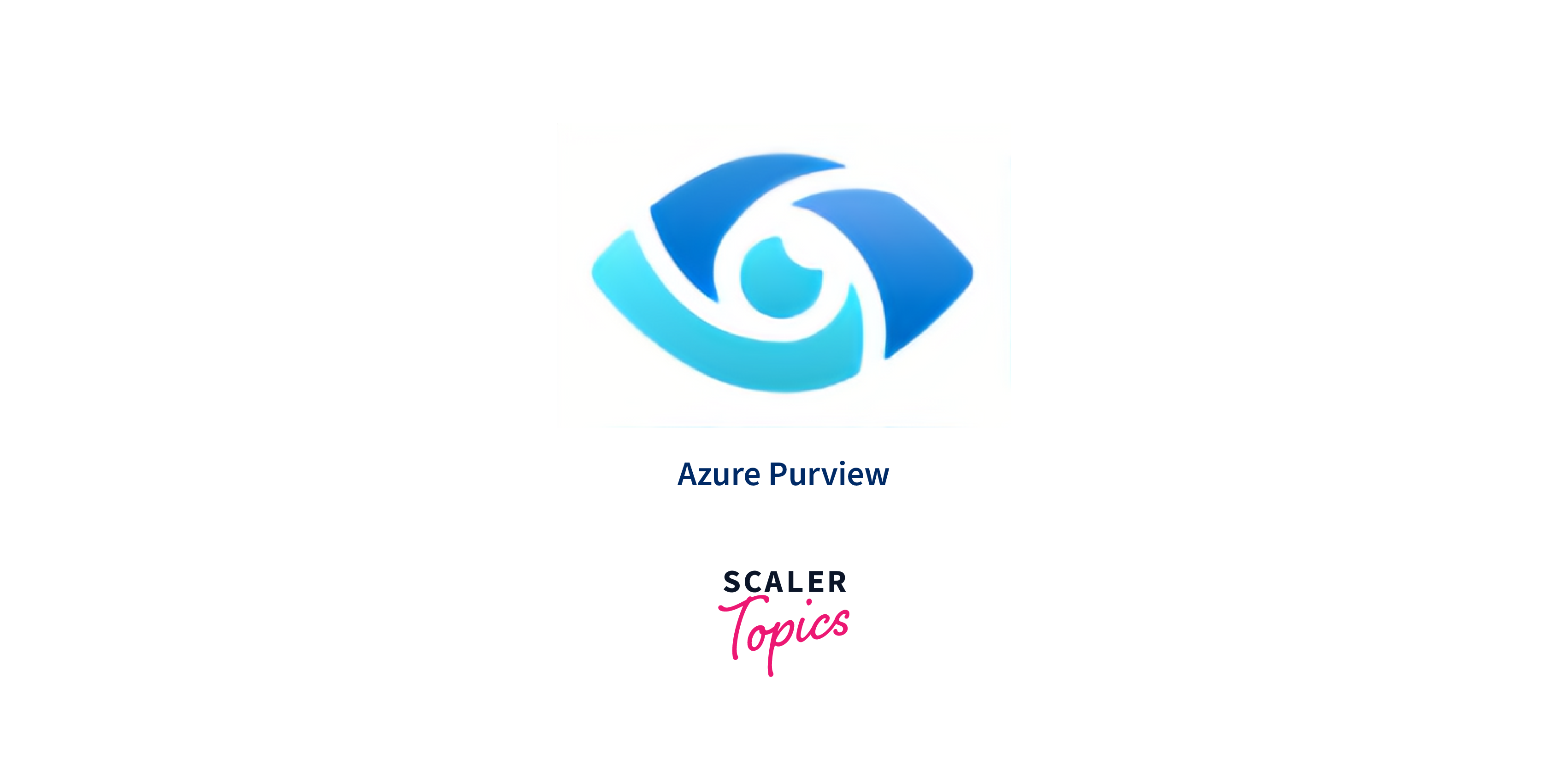
Azure Purview Roles
Azure Purview provides several built-in roles that control access to different features and actions within the service. These roles help in defining fine-grained access control for users and groups. Some of the key built-in roles in Azure Purview are:
- Purview Data Curator:
This role allows users to curate data and manage data sources, classifications, and glossaries within Azure Purview. - Purview Data Source Administrator:
Users with this role have permission to manage data sources, including creating, updating, and deleting them. - Purview Data Map Reader:
This role grants read-only access to the data maps and associated metadata. - Purview Data Map Contributor:
Users with this role can contribute to data maps, making it possible to add or modify metadata for data assets. - Purview Data Map Administrator:
This role provides full administrative control over data maps, including management and governance of metadata. - Purview Account Administrator:
This role is responsible for managing the Azure Purview account, including configuration settings and access control. - Purview Catalog Reader:
Users with this role have read-only access to the Azure Purview catalog, enabling them to view data assets and metadata. - Purview Catalog Contributor:
This role allows users to contribute to the Azure Purview catalog by adding, modifying, or deleting data assets and metadata. - Purview Catalog Administrator:
Users with this role have full administrative control over the Azure Purview catalog, including managing data assets and metadata.
Azure Purview Data Map
Azure Purview Data Map is a feature of Azure Purview that offers a centralized view of an organization's data assets and metadata. Some of its key features are:
- It enables data discovery across on-premises, multi-cloud, and SaaS sources, simplifying access to data.
- Data Map captures and manages metadata, including data lineage, classifications, and data quality, aiding in data understanding.
- It facilitates data governance by enforcing policies, ensuring compliance, and tracking data access and usage.
- Data Map encourages collaboration and knowledge sharing among teams and users.
- It provides insights and analytics on data usage and relationships, supporting data-driven decision-making.
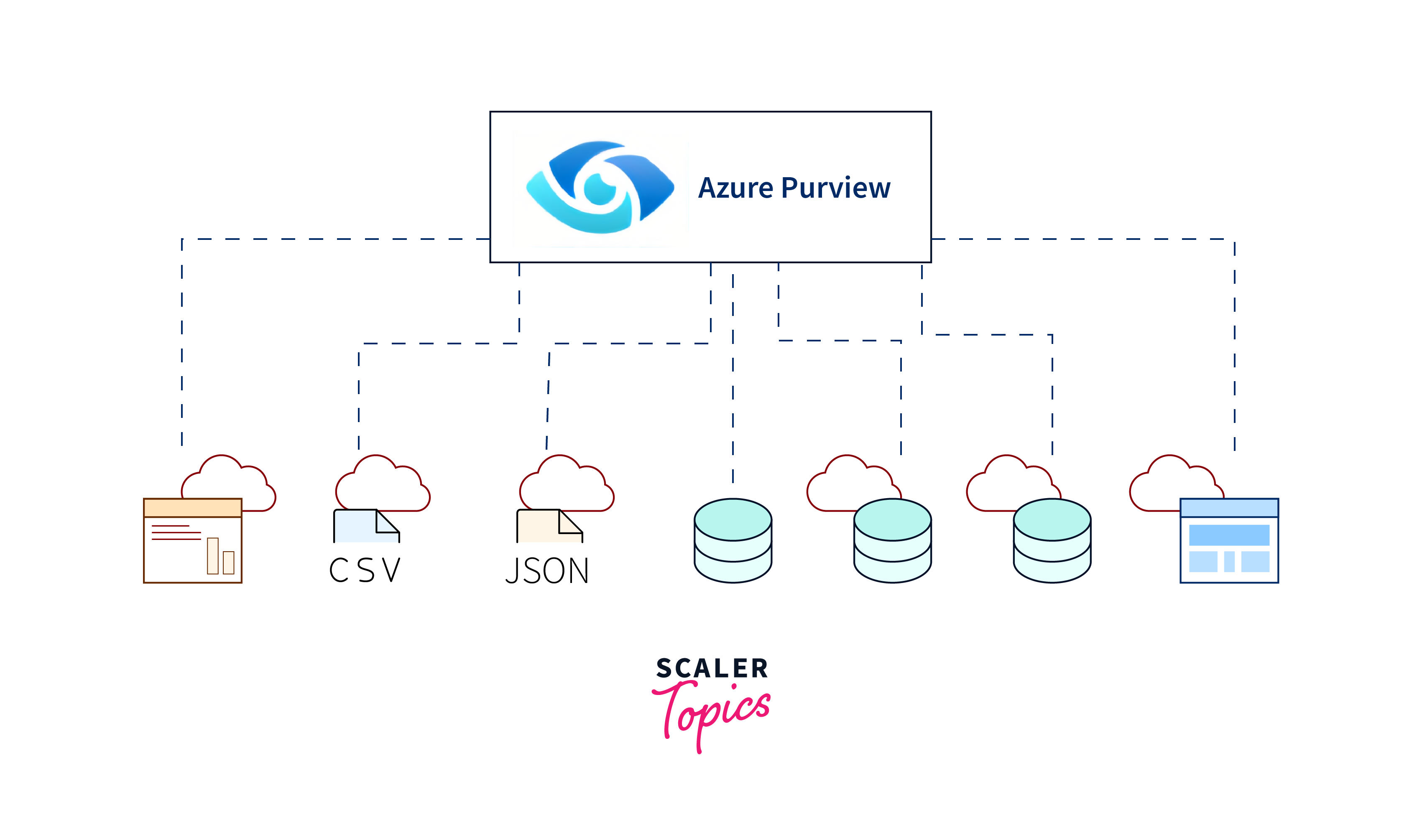
Azure Purview Data Catalog
- Azure Purview Data Catalog is a component of Azure Purview that serves as a fully managed metadata repository.
- It allows users to discover, register, and manage data assets across various data sources, making data more discoverable and accessible.
- Data Catalog enables users to document metadata, data lineage, data classifications, and glossary terms, enhancing data understanding and governance.
- It provides a unified view of data assets, both on-premises and in the cloud, facilitating collaboration and data insights for better decision-making.
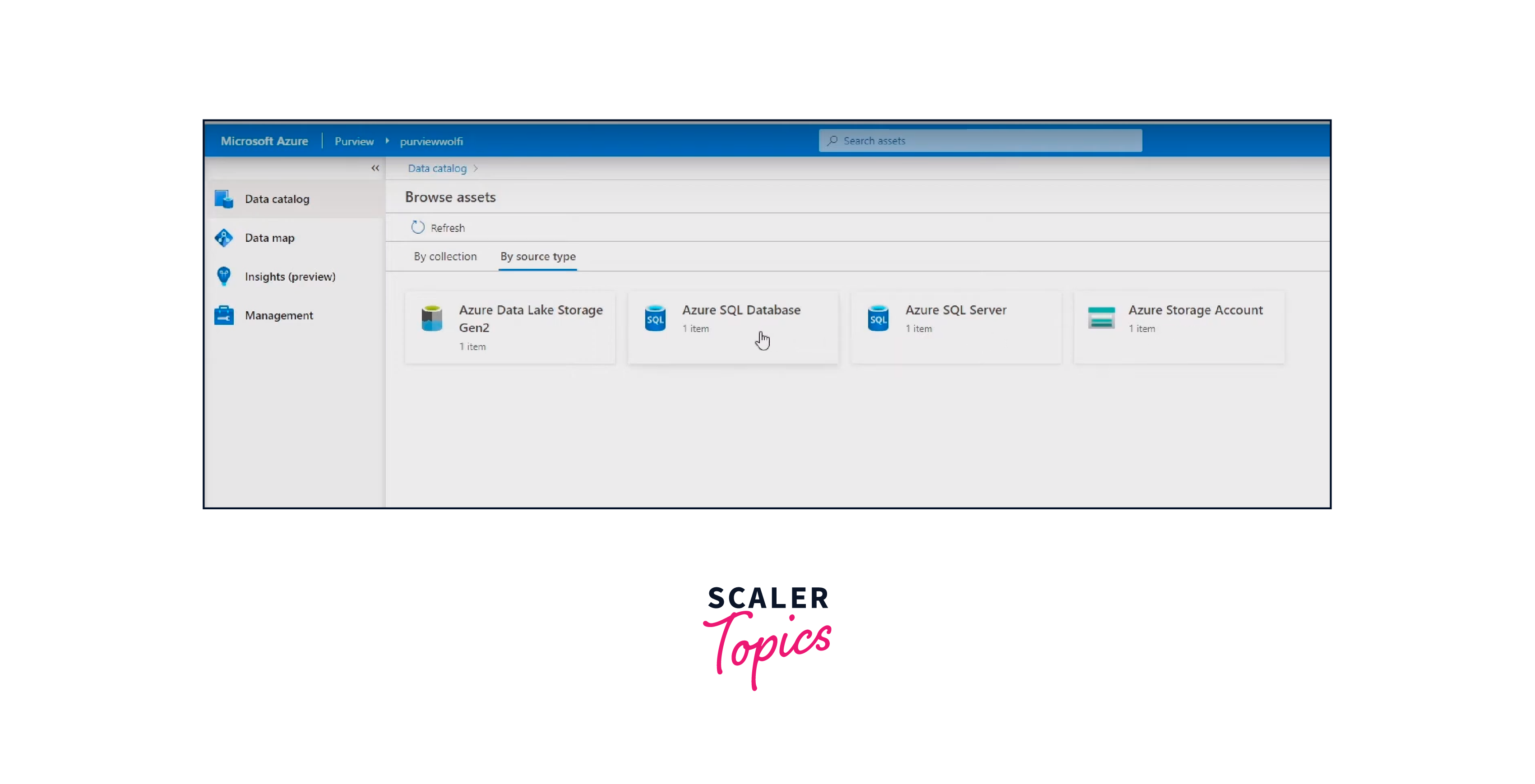
Azure Purview Data Estate Insights
In Azure, a data estate refers to the entirety of an organization's data assets, both structured and unstructured, residing in various data sources across the cloud and on-premises environments. It encompasses data from databases, data warehouses, data lakes, applications, and other sources, forming a comprehensive repository of an organization's data. Azure provides a suite of services and tools to manage, process, and analyze this data estate efficiently and securely.
Azure Purview Data Estate Insights is a feature within Azure Purview that provides a comprehensive overview of an organization's data estate.
- It offers insights into data usage, data quality, data lineage, and data asset relationships.
- Data Estate Insights helps organizations understand their data landscape, identify data usage patterns, and optimize data management practices.
- By visualizing data relationships and lineage, enables users to make informed decisions, improve data governance, and enhance data compliance
Data Lineage Visualisation
Data lineage refers to the end-to-end traceability and documentation of the origin, transformation, movement, and consumption of data within a system or process. It helps to understand the data's journey, ensuring data quality, compliance, and providing insights into how data is used and modified over time.
Data lineage visualization is the graphical representation of the end-to-end data flow and transformation processes within an organization's data ecosystem. It visually illustrates the origins, movement, and transformations of data from its source to its destination. With data lineage visualization, users can track data through various stages, understand dependencies, and ensure data accuracy and compliance.
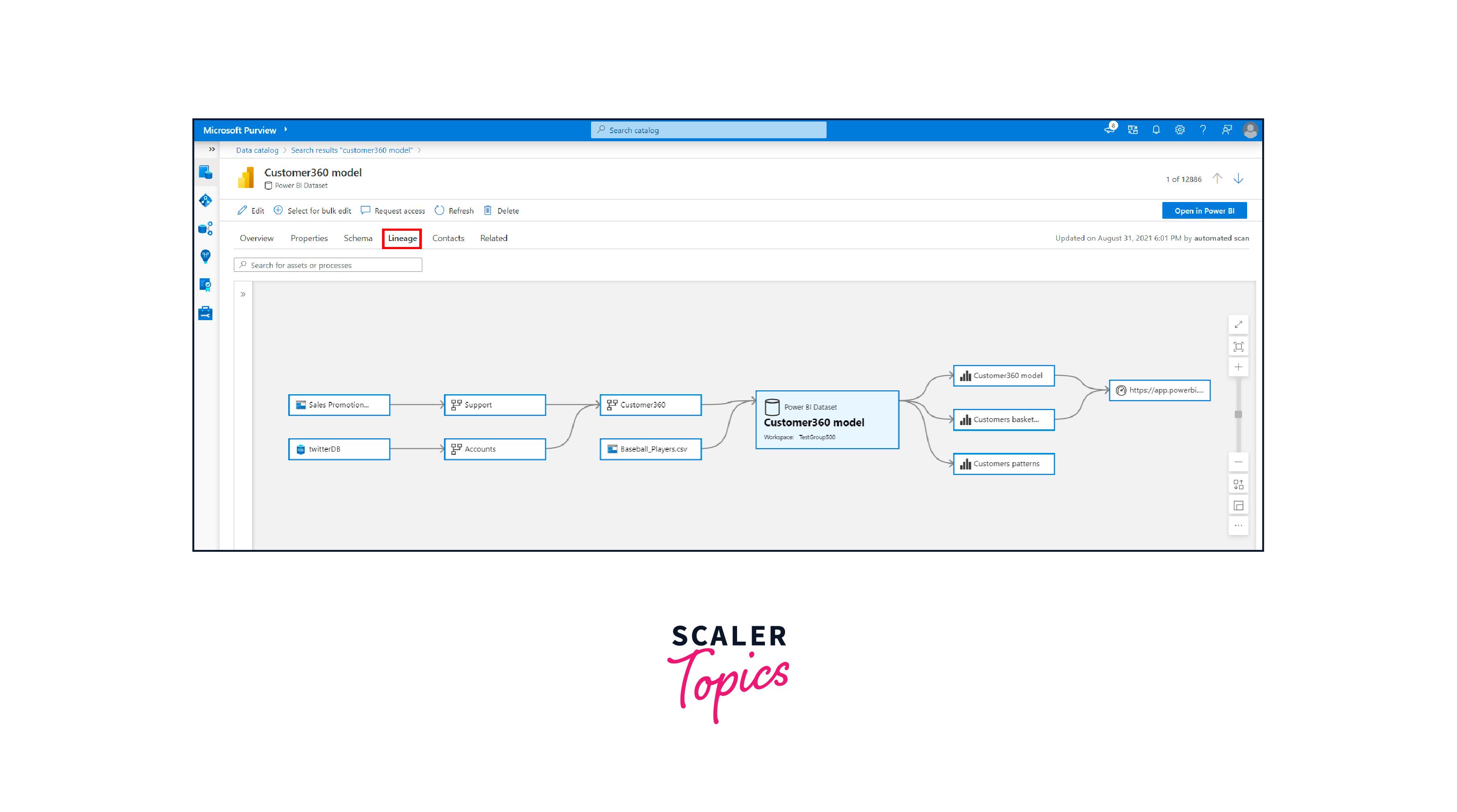
It helps in identifying data sources, understanding data transformations, and maintaining data integrity and governance throughout the data lifecycle. Azure Purview allows us to visualize this.
Key Features and Benefits
Key Features of Azure Purview:
- Data Catalog:
Centralized metadata repository to discover and explore data assets across the organization. - Data Map:
Visual representation of data relationships, enabling a better understanding of data flows and dependencies. - Data Lineage: Clear visualization of data lineage to track data origins, transformations, and usage.
- Data Classification:
Automatic and manual classification of sensitive data to enforce security and compliance. - Data Governance:
Policy-driven data governance to ensure data quality, privacy, and regulatory compliance. - Data Insights:
AI-driven insights and recommendations for data optimization and data estate management. - Integration:
Seamless integration with Azure services and other data platforms for comprehensive data management.
Benefits of Azure Purview:
- Improved Data Discovery:
Easily locate and access data assets across the organization with a centralized data catalog. - Enhanced Data Governance:
Implement data policies, classification, and compliance measures to ensure data security and privacy. - Increased Data Understanding:
Visualize data flows and lineage to gain insights into data relationships and dependencies. - Efficient Data Collaboration:
Facilitate collaboration among data users and stakeholders through shared metadata. - AI-Powered Insights:
Leverage AI-driven recommendations to optimize data usage and enhance data estate management. - Simplified Compliance:
Meet regulatory requirements and industry standards by enforcing data governance policies. - Scalability and Integration:
Seamlessly integrate with existing data platforms and scale to meet growing data needs.
Azure Purview Workflow
Workflows in Azure Purview are sequences of orchestrated activities that automate data management tasks. They enable users to automate data discovery, data classification, and data lineage processes.
- Workflows help streamline data governance and compliance efforts by automating data organization and metadata management.
- Users can customize workflows to match their specific data governance requirements and compliance policies.
- Data stewards, data engineers, and data analysts can use workflows to efficiently manage and govern data assets.
- Workflows enhance data visibility and enable better data-driven decision-making processes.
- With workflows, data management tasks become more efficient, scalable, and consistent across the organization.
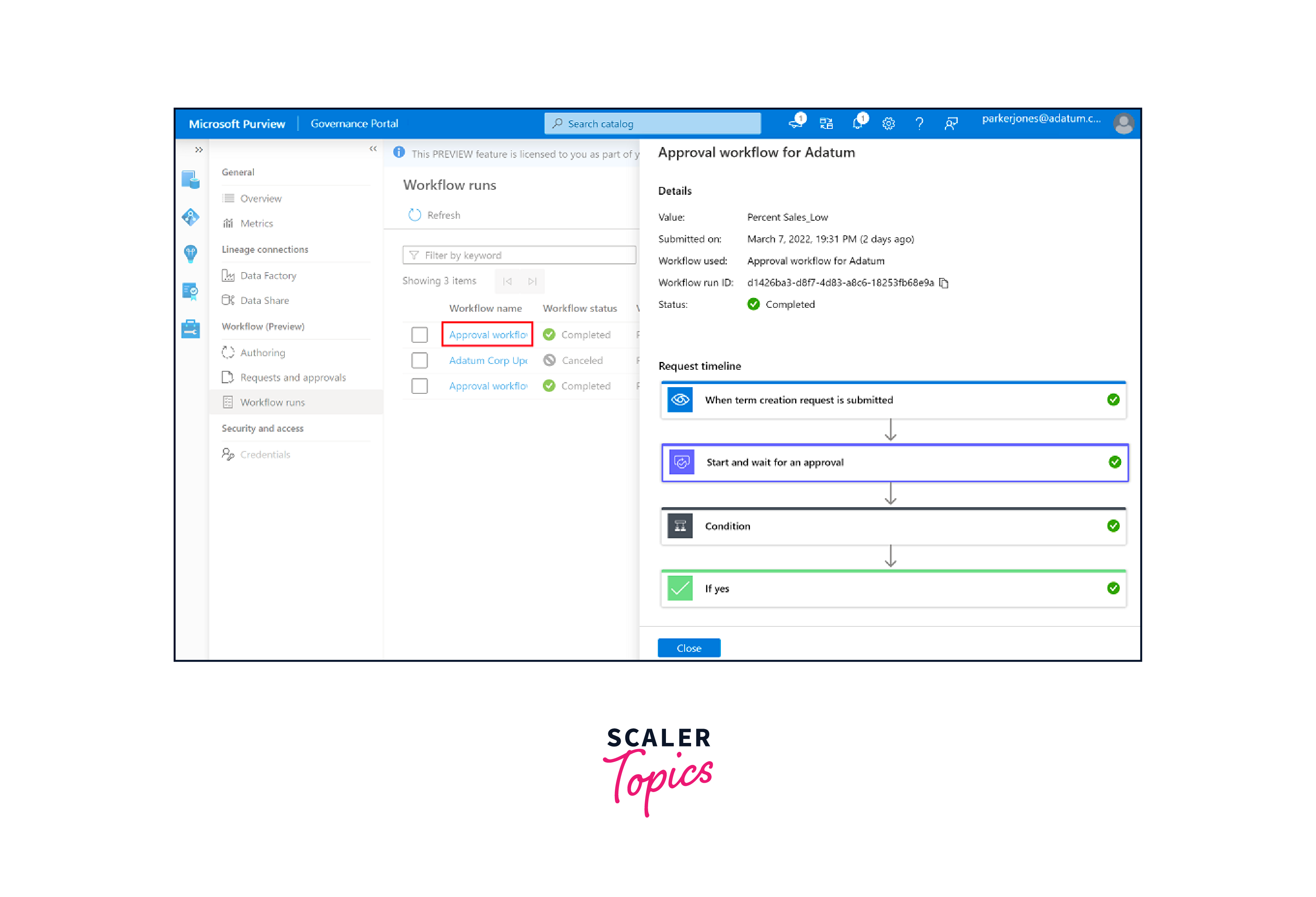
Create a Unified Map of Your Data Across Hybrid Sources
For unified Data Mapping for Effective Governance, the following things are considered:
- Simplify data management across hybrid sources through automation and metadata management.
- Efficiently classify data with customizable classifiers and Microsoft Information Protection labels.
- Ensure consistent labelling of sensitive data across SQL Server, Azure, Microsoft 365, and Power BI.
- Seamlessly integrate data systems with Apache Atlas APIs for unified access and control.
Enable Effortless Discovery of Trusted Data
Simplify Data Exploration with Azure Purview Data Catalog:
- Facilitate smooth data search using both technical and business terminologies for seamless discovery.
- Comprehend data effortlessly by exploring relevant technical, business, semantic, and operational metadata.
- Swiftly determine data sensitivity levels to uphold governance and compliance standards.
- Visualize interactive data lineage to easily track data origins and flow.
- Provide data scientists, engineers, and analysts with contextual information to drive meaningful BI, analytics, AI, and machine learning projects.
Discover Data that Powers Business Insights
Uncover Valuable Data for Informed Business Decisions:
- Gain insight into your data supply chain, starting from raw data to valuable business insights.
- Seamlessly link Azure Purview with Azure Data Factory instances to automatically gather data integration lineage. Azure Data Factory is Microsoft's cloud-based data integration service for orchestrating and automating data workflows.
- Efficiently identify existing analytics and reports, avoiding redundant work and streamlining the decision-making process.
Conclusion
- Azure Purview is a data governance service that helps organizations discover, catalogue, and manage data assets across various sources. It provides a unified view of data, enabling insights into data lineage, policies, and compliance.
- Azure Purview offers built-in roles for access control, allowing fine-grained permissions for users and groups.
- The Purview Data Map automates metadata management, data classification, and sensitivity labelling across SQL Server, Azure, Microsoft 365, and Power BI.
- The Purview Data Catalog facilitates data discovery, search, and understanding with associated metadata.
- Azure Purview Data Estate Insights provides comprehensive insights into an organization's data estate, improving data management practices.
- Data lineage visualization enables tracking data flow, transformations, and maintaining data integrity.
- Key features include data classification, governance, AI-driven insights, and seamless integration with Azure services.
